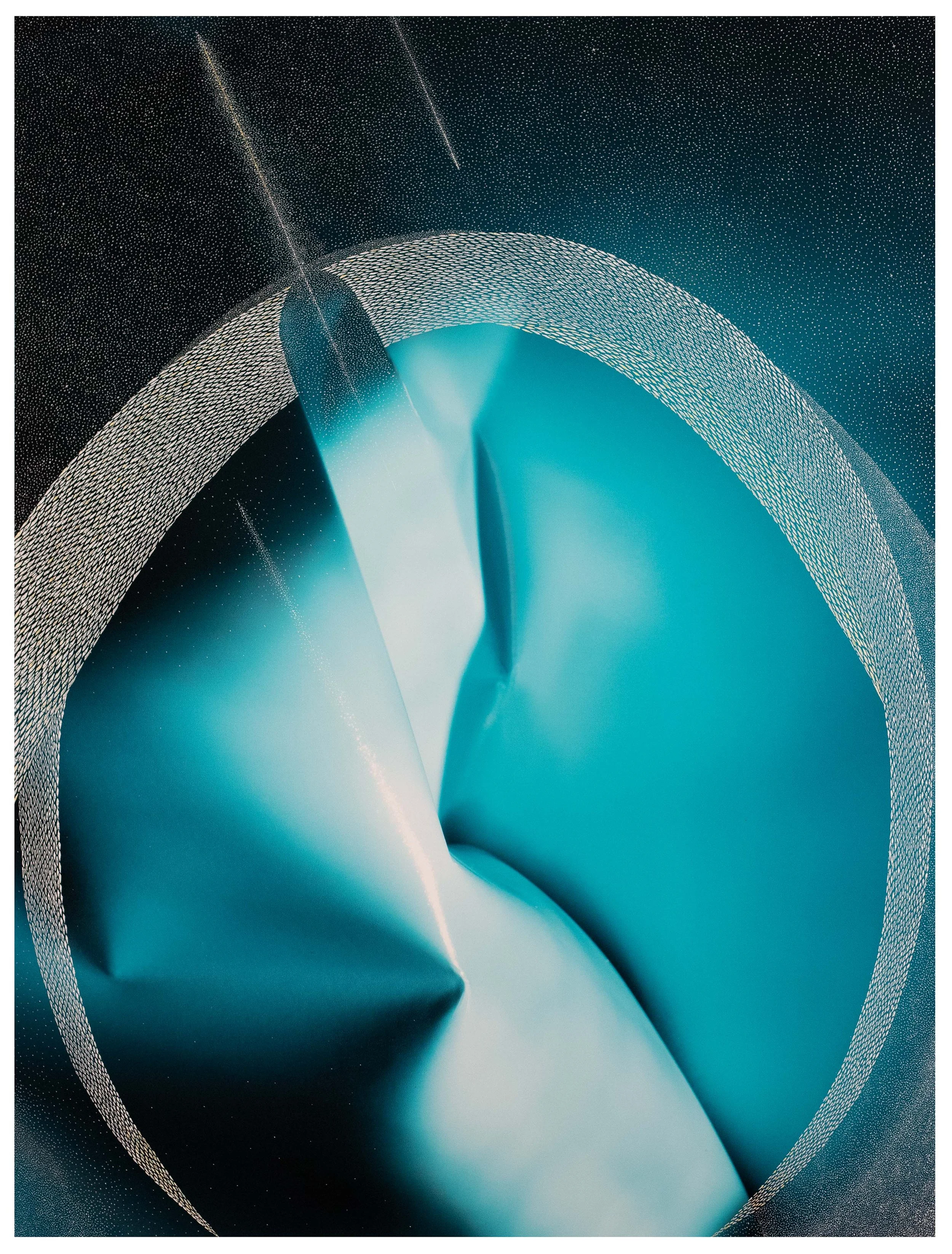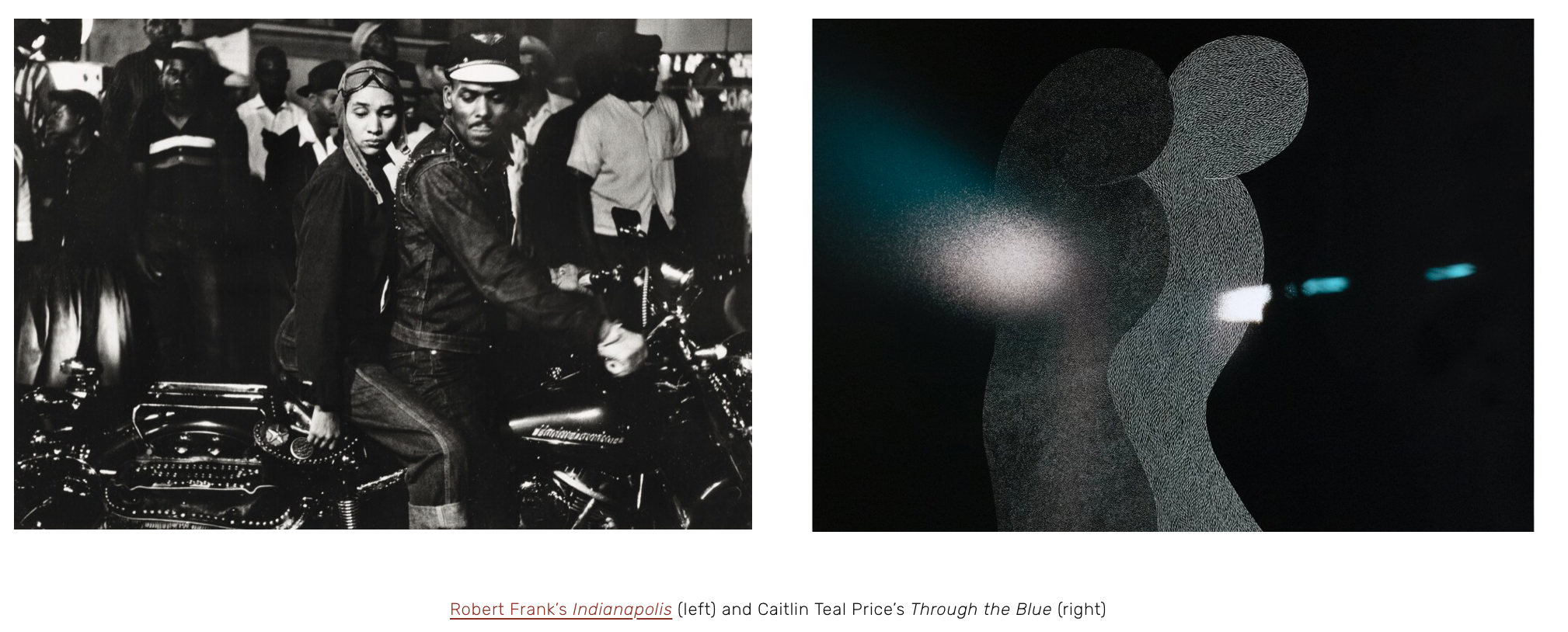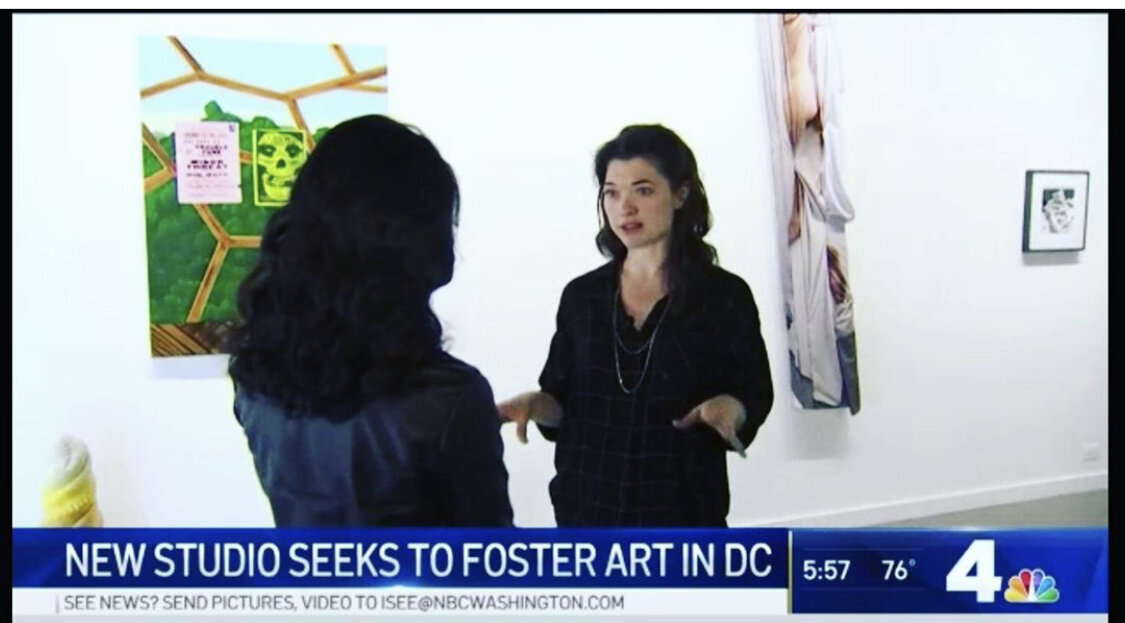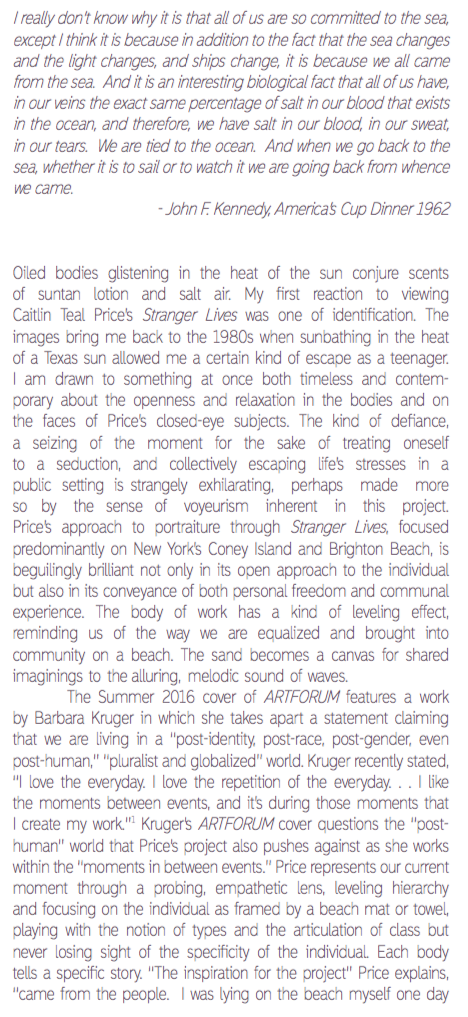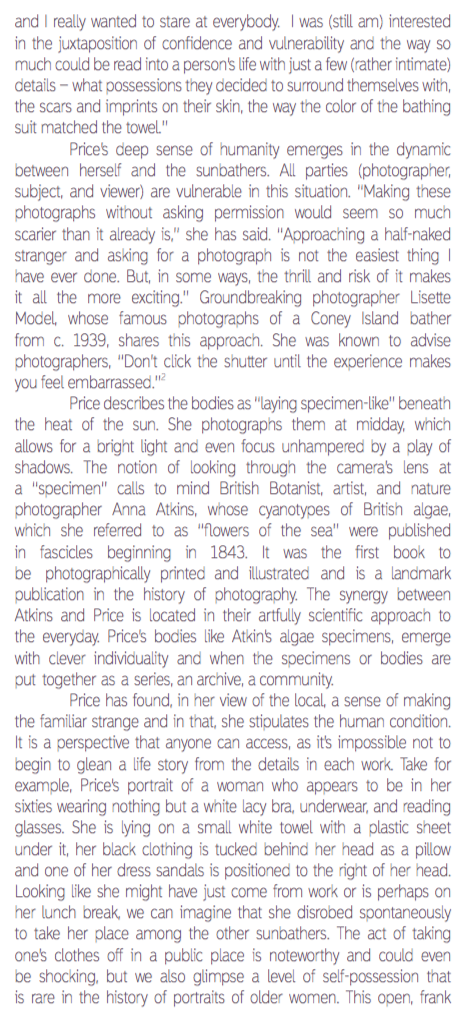Kaitlin Booher : Hello Caitlin! Let’s start at the beginning, what is Stranger Lives?
Caitlin Teal Price : Stranger Lives is a series I worked on for two weeks every August between 2008 and 2015. I would walk the beaches at Coney Island and Brighton Beach from noon until 2 pm when the sun was hot and high, so I could get glistening bodies and sharp focus. I wanted to capture every little detail that I could. The work itself is about the lives of these strangers—what you can discern about a person from the markings on their bodies, their scars, wrinkles, and the objects they surround themselves with—that is what drew me to making this work, and it was those details that motivated me to approach so many people over such a long period of time.
KB: You’ve spoken elsewhere about how you would wear a red dress and try to make yourself visible but disarming when asking people’s permission to photograph them. But you were photographing with a bulky, professional-looking camera. Do you think your camera played a role in your interaction with strangers?
CTP: I would notice other photographers; they were mostly men with telephoto lenses strapped around their neck walking along the shore taking pictures of people splashing in the waves or something. So, I think in general, I didn’t blend in with typical beach photographer. I used a Mamiya RZ-67 medium-format camera which is quite large and does present as official. It is unusual to see a woman carrying one on her hip through crowds of sunbathers. I think my camera helped me stand out, which was part of my strategy with the red dress, too. I wasn’t a creepy photographer but a recognizable regular on the beach, which in my mind made me less threatening, which in turn made me feel more comfortable approaching strangers. I think that confidence helped put people at ease.
One thing I love about this series is the uniformity of the composition of your photos, because it makes the diversity of bodies, adornments, and clothing stand out. How soon did you figure out the scope of this series? Was there one photo that set the format for the rest?It took me a few weeks to figure it out. At first, I was really interested in couples whose bodies were intertwined with one another and showing affection in public, each image was different. But I quickly realized that strangers on their own were endlessly interesting and that I didn’t need to introduce the relationship aspect. I have always been attracted to typologies, so I zeroed in on the format quickly after that.
It's striking how everyone’s eyes are closed. How much would you need to direct people? Would people ever want to smile or pose?
I only approached people who were already lying on their backs. So, they were naturally posed for the photograph before I spoke to them. I would never ask them to move. And I never moved anything around them. Once they agreed to be photographed—and about 50% of the people I approached did —all I asked them to do was close their eyes and ignore me. Sometimes people wanted to pose, or they instinctually would, but I would encourage them to relax. I think this series would be completely different if the strangers’ eyes were open. A different relationship occurs when there is eye contact.
The guy in the white speedo breaks the mold.
Yeah, he does, and there are a few that do. It bothered me for a while that he struck a pose, but the picture still works and in the end that’s what matters.
What is particular or special about the people at Coney Island and Brighton Beach? Did you photograph sunbathers in other places?
I went to Miami and to a few beaches in California, but they were never as fruitful. For a few reasons, I think. One, those beaches were simply not as packed. In New York you have this the density of people who just flow off the Subway and onto the beach. There is also a rawness in New York that I didn’t find in other places. People in New York are used to being in their own worlds, not caring what people around them think. They are ok with who they are, with presenting themselves in public without too much thought sometimes. And in New York especially, the beach is a place where you can let it all hang out. The other thing about New York is that it’s such a melting pot. There are SO MANY different types of people and I was looking for all types of people.
And for New York City dwellers living in tiny apartments, public space is ironically an important private space. Combine this with the universal strangeness of the beach as public space.
Going out and getting space in New York is a really big thing. Of course, the beach is unlike any other public space because you take off your clothes and sleep. It is weird to photograph someone with clothes on at the beach. I've got [images of] a couple people who are fully clothed and they look totally out of place.
Would people be confused when you approached them?
Some were confused, some were just blissed out. I never knew what I was going to get. I would walk over to someone and just be as nice as possible. I smiled a lot. I would crouch down, and say: “excuse me, I’m a photographer photographing people laying on the beach and you look perfect. Do you mind If I take your picture? You can close your eyes and totally ignore me. I’ll be gone in a second.” Sometimes they would sit up and talk to me, sometimes they would just say yes and close their eyes and ignore me, and sometimes they would tell me to scram! After I made the picture, some would ask to see it, because they assumed it was digital, but it was film, so no one ever saw the image. And I never followed up because I wanted to keep everyone as strangers. That was part of it for me. I wanted to learn about these people through the image.
Of course, for artistic purposes such as yours, you did not need a model release.
I thought about this a lot. But in the end I figured, they are in public, I asked permission, Philip- Lorca diCorcia went through that lawsuit and won.. At the time, I thought that asking for a release would have been even more intrusive. It would have raised more eyebrows and would have elicited more questions. I wasn’t trying to be sneaky. It just would have been too much. I really didn’t want to disturb these people more.
There’s an ethics to that. Plenty of street photographers working in a similar location--I’m thinking of Lisette Model in the 1940s--would just go ahead and photograph people who were asleep and unaware.
I couldn’t have done this without asking. My camera had to be focused, and I would stand so close to the subjects, so it’s already so intrusive. The dudes walking the beach with long lenses were different.
Has anyone ever recognized themselves or friends and gotten in touch with you?
No one has ever recognized themselves or got in touch.
I feel like they will eventually! In the last decade or so, women in Robert Frank or Garry Winogrand’s photographs have recognized themselves.
Let’s talk about the title Stranger Lives. Did it come to you immediately?
I was calling it “Washed Up” for a long time, because in addition to strangers I was interested in the intersection between life and death and the subtext in my mind as I was talking along the beach was that these bodies were washed up on the sand. These people were in their casket, and this is how I can tell who they are. But those ideas were a bit too dark and I eventually started seeing them as alive and well strangers! For the record, I did adopt this title before the show Stranger Things came out!
Were you ever tempted to zoom out and depict more of the beach, or some of the iconic amusement park?
I took a couple of pictures with Coney in the background, but for the series I didn’t want to give the images a place. I wanted to keep the images about the specific person and not the whole environmental context.
The small details are what amaze me about these images, and they continue to reveal themselves the longer you look at them. Even after looking at them hundreds of times, it was only when I was printing them that I noticed certain things. There are layers of reveal, which I think is pretty cool.
I thought there was a bigger pool of images, given the duration of this series!
Yeah, some days I would only ask 5 or 6 people for a photograph and only 2 of them would say yes. It was not easy to get the images and I was very selective with who I decided to approach. It was like casting for me. And I really only asked people who I was interested in. Over the course of the summer I could get anywhere from 10-15 new pictures and now there are about 75 in the series.
Did you ever photograph the same person twice?
Yes! A few times. Twice was on purpose. I had seen them in previous years, they were nice and the pictures I got of them weren’t great, so I asked again. They both said yes a second time! That was nice. Another time was not on purpose. I approached this girl with the most amazing nails and she said, “you photographed me yesterday!” That was embarrassing. I saw so many people it was hard to keep track sometimes. I was always scared I would ask someone who had already said no.
What about the images of two or more people? I’m looking at this photo of two girls in the pink bikinis who are almost twins and wearing lots of makeup.
Interactions between two people was re-introduced probably in the last year or two that I was making these pictures. I started re-thinking about pairs of people, and how a significant other or a friend can become a kind of prop in your life. The pairs of people usually focus on one of the two people in the frame.
The people we surround ourselves with play a big role in defining our lives and roles, in the same way that we fashion and define ourselves through clothes and belongings. It’s all a way of communicating who you are to the world.
I totally agree. I explored that theme in my series Annabelle, Annabelle too, which actually arose out of the Stranger Lives pictures. In Annabelle, Annabelle the images of woman are staged and every one of them has a prop, something I planted, that communicated a hint of who these characters were.
Interesting! And I think you can draw a line from Stranger Lives to the abstractions you’re currently making, in terms of light and color and form.
You totally can, there’s a progression and it makes sense. Unless you’re versed in art it’s hard because they look so different. With all my series, it’s particular to a certain time in my life and what’s going on, but they’re exploring the same themes in different visual ways. And now I’m making abstract pictures based on photographs, making abstract shapes from daily life, which comes back into themes about the spirit, light, form.
And the strangers depicted are, on some level, abstractions of real people.
Absolutely, we see one little moment in a complicated life. Its totally abstracted from reality. In a visual way, if you block out details, you get shapes that move towards abstraction, which is something I was thinking about as I was laying out my book. It’s also something I am thinking a lot about with my work today. Its a thing in and of itself.
The subject’s positioning in space can seem disorienting.
I can see why you say that. Some people want to see them vertically and I think it’s because we are used to seeing people standing upright. But, for me when you look at them vertically, they are even more disorienting.
Stranger Lives will be a particular marker of a specific time, like photographs made at Coney Island in the 1940s. I’m thinking of Weegee’s image of the crowds there during a heatwave or photographs that Lisette Model or Sid Grossman took of people swimming and hanging out on the beach.
I think so, the way people dress and sunbathe is already changing and the work is already aging – for instance, there are plastic bags everywhere and there aren’t a lot of phones. Honestly, I don’t know if people would let me photograph them like this today. Social media has really changed things. When I began the series in 2008, I didn’t have a smart phone and I certainly wasn’t on Instagram. I wonder if people would say yes today, or if I would have the same amount of luck as when I was making the work originally.
You worked on this project for a long time, 2008 to 15, how did you know when it was complete?
When I made the book [published by Capricious] in 2016, I felt like it was a good time to end. I had made 90+ pictures, I had two kids, it was harder to do it the project. I had to say “OK, this is it.” I could have kept going, but I like it as a time capsule now.
After a year of social distancing, how does it feel to revisit this series?
The exhibition So Hot You Could Fry an Egg is about the summer and heat. After having such an intense year, having a show that’s the opposite is fun. I think about this work and how it aged, I've always thought about how it will look in 10 years, now it is starting to seem like a marker of a specific, pre-Instagram time.
It is also nice to see these prints installed in a gallery, in person. The prints themselves are life-size, so it can feel sort of voyeuristic. Something uncomfortable can happen for the viewer, it’s like you can’t look and you can’t look away, and I think this is an effect of them being so large.
Kaitlin Booher is an independent curator and Ph.D. candidate in art history at Rutgers University. She is currently the Jane and Morgan Whitney Fellow in the Department of Photography at the Metropolitan Museum of Art.
